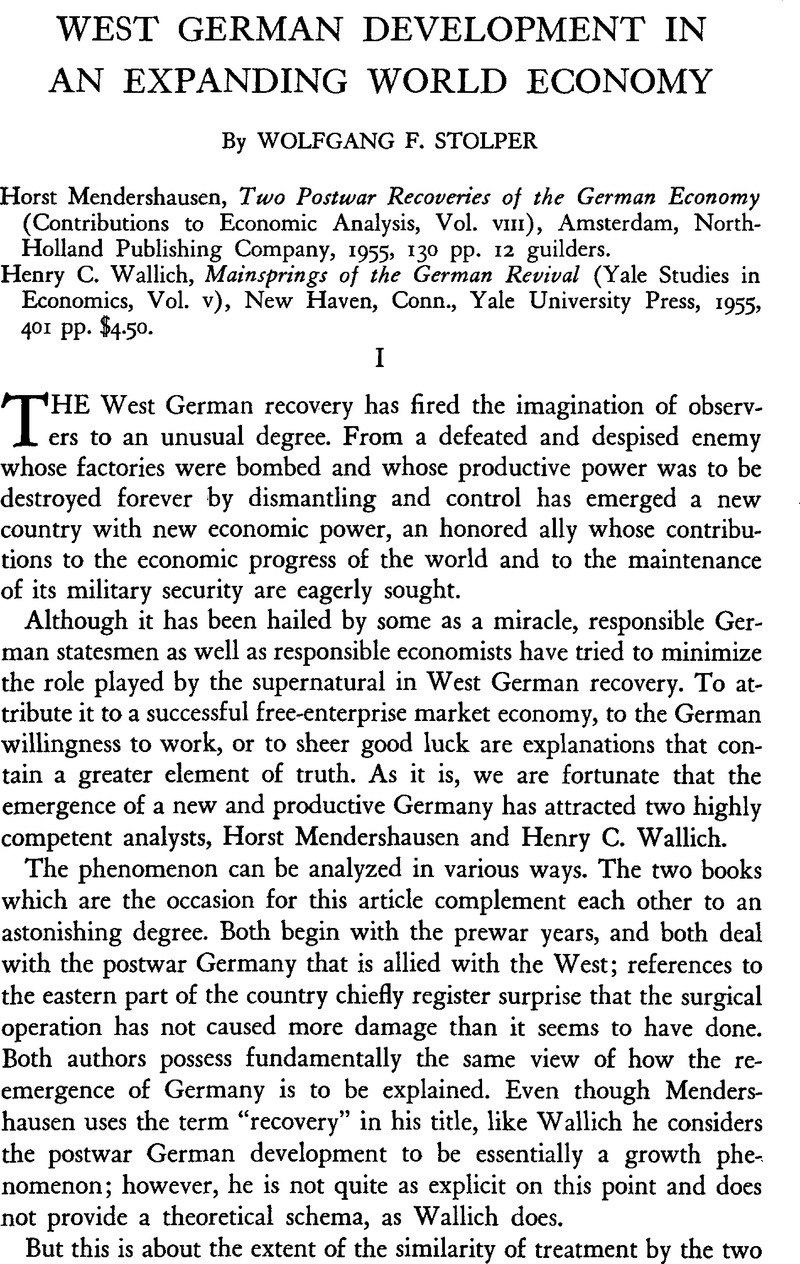No CrossRef data available.
Article contents
West German Development in an Expanding World Economy
Published online by Cambridge University Press: 18 July 2011
Abstract

- Type
- Review Articles
- Information
- Copyright
- Copyright © Trustees of Princeton University 1956
References
1 I am told that a Soviet Russian critique of the book stresses this point and complains that East Germany is left out of the picture. This article tries to amend the “oversight.”
2 The index given by Mendershausen (Table 1, p. 6, taken from Vierteljahreshefte zur Konjunkturforschung) does not agree with the index published in Statistisches Jahrbuch, 1939–1940, p. 57*, which uses 1928 = 100 as the index basis. In the following, Mendershausen's index has been recalculated on the same basis:

3 Or is one man's luck another man's miracle?
4 In this particular case, comparison with 1938 raises difficulties in that the Nazis pursued autarkic policies. But these policies probably affected imports of certain products more than imports as a whole.
5 Wallich's book contains an interesting discussion as to whether this reversal was due to the fact that Adenauer rather than Schumacher won the elections. There is little doubt that at present the Socialists would not deviate much from Erhard's policies, although they might from Schäffer's. But what they would have done in 1949–1950 is uncertain.
6 ECE, Growth and Stagnation, op.cit., p. 31.Google Scholar
7 This is, for instance, the opinion of Professor Karl Schiller. See his discussion in Deutschland und die Weltwirtschaft, Schriften des Vereins für Sozialpolitik, N.S., Vol. X, Berlin, 1954, pp. 191ff.
8 Many Central German businesses continue to exist as nationalized enterprises in East Germany, and as newly developed private enterprises in West Germany, using the same trademarks, etc. Zeiss and Breitkopf and Härtel are but two well-known examples.
9 Statistisches Jahrbuch, 1955 ed., p. 75*. The pre-World War II figures refer to the area of the Reich, and the post-World War II figures to the area of the Federal Republic. Interzonal trade is not included.
10 For an interesting account of German foreign trade policies and attitudes as of 1954, see Reinhardt, H., “Gegenwartsprobleme der deutschen Aussenhandelspolitik,” in Deutschland und die Weltwirtschaft, op.cit., pp. 123ff. Mr. Reinhardt is an official in the Erhard ministry.Google Scholar
11 The differences between the new and the old economics are partly real and partly semantic. What is certainly real is that we are much less willing than we were in the 1920's and early 1930's to take things lying down and accept depressions as if they were earthquakes. Yet, at least in Schumpeter's scheme of things, in which recession and depression have technical meanings (the former being a movement toward equilibrium, the latter being a movement away from it), depressions were always unnecessary, and unavoidable recessions could theoretically be kept at a level at which they were neither social catastrophes nor much more than statistically observable phenomena.




